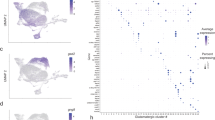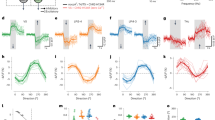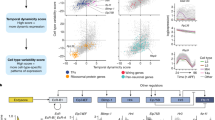Abstract
Photoreceptor neurons (R cells) in the Drosophila visual system elaborate a precise map of visual space in the brain. The eye contains some 750 identical modules called ommatidia, each containing eight photoreceptor cells (R1–R8). Cells R1–R6 synapse in the lamina; R7 and R8 extend through the lamina and terminate in the underlying medulla. In a screen for visual behavior mutants, we identified alleles of flamingo (fmi) that disrupt the precise maps elaborated by these neurons. These mutant R1–R6 neurons select spatially inappropriate targets in the lamina. During target selection, Flamingo protein is dynamically expressed in R1–R6 growth cones. Loss of fmi function in R cells also disrupts the local pattern of synaptic terminals in the medulla, and Flamingo is transiently expressed in R8 axons as they enter the target region. We propose that Flamingo-mediated interactions between R-cell growth cones within the target field regulate target selection.
This is a preview of subscription content, access via your institution
Access options
Subscribe to this journal
Receive 12 print issues and online access
$209.00 per year
only $17.42 per issue
Buy this article
- Purchase on Springer Link
- Instant access to full article PDF
Prices may be subject to local taxes which are calculated during checkout








Similar content being viewed by others
References
Tessier-Lavigne, M. & Goodman, C.S. The molecular biology of axon guidance. Science 274, 1123–1133 (1996).
Flanagan, J.G. & Vanderhaeghen, P. The ephrins and Eph receptors in neural development. Annual Review of Neuroscience 21, 309–345 (1998).
Inoue, A. & Sanes, J.R. Lamina-specific connectivity in the brain: regulation by N-cadherin, neurotrophins, and glycoconjugates. Science 276, 1428–1431 (1997).
Lee, C.-H., Herman, T., Clandinin, T.R., Lee, R. & Zipursky, S.L. N-cadherin regulates target specificity in the Drosophila visual system. Neuron 30, 437–450 (2001).
Yamagata, M., Weiner, J.A. & Sanes, J.R. Sidekicks: synaptic adhesion molecules that promote lamina-specific connectivity in the retina. Cell 110, 649–660 (2002).
Huh, G.S. et al. Functional requirement for class I MHC in CNS development and plasticity. Science 290, 2155–2159 (2000).
Shen, K. & Bargmann, C.I. The immunoglobulin superfamily protein SYG-1 determines the location of specific synapses in C. elegans. Cell 112, 619–630 (2003).
Schmucker, D. et al. Drosophila Dscam is an axon guidance receptor exhibiting extraordinary molecular diversity. Cell 101, 671–684 (2000).
Wang, F., Nemes, A., Mendelsohn, M. & Axel, R. Odorant receptors govern the formation of a precise topographic map. Cell 93, 47–60 (1998).
Scheiffele, P., Fan, J., Choih, J., Fetter, R. & Serafini, T. Neuroligin expressed in nonneuronal cells triggers presynaptic development in contacting axons. Cell 101, 657–669 (2000).
Biederer, T. et al. SynCAM, a synaptic adhesion molecule that drives synapse assembly. Science 297, 1525–1531 (2002).
Katz, L.C. & Shatz, C.J. Synaptic activity and the construction of cortical circuits. Science 274, 1133–1138 (1996).
Crowley, J.C. & Katz, L.C. Development of ocular dominance columns in the absence of retinal input. Nat. Neurosci. 2, 1125–1130 (1999).
Lin, D.M. et al. Formation of precise connections in the olfactory bulb occurs in the absence of odorant-evoked neuronal activity. Neuron 26, 69–80 (2000).
Clandinin, T.R. & Zipursky, S.L. Making connections in the fly visual system. Neuron 35, 827–841 (2002).
Meinertzhagen, I.A. & Hanson, T.E. in The Development of Drosophila melanogaster (eds. Bate, M. & Martinez-Arias, A.) 1363–1491 (Cold Spring Harbor Press, Cold Spring Harbor, 1993).
Kirschfeld, K. Die projektion der optischen unwelt auf das raster der rhabdomere im komplexauge von Musca. Exp. Brain Res. 3, 248–270 (1967).
Perez, S.E. & Steller, H. Migration of glial cells into retinal axon target field in Drosophila melanogaster. J. Neurobiol. 30, 359–573 (1996).
Poeck, B., Fischer, S., Gunning, D., Zipursky, S.L. & Salecker, I. Glial cells mediate target layer selection of retinal axons in the developing visual system of Drosophila. Neuron 29, 99–113 (2001).
Clandinin, T.R. & Zipursky, S.L. Afferent growth cone interactions control synaptic specificity in the Drosophila visual system. Neuron 28, 427–436 (2000).
Usui, T. et al. Flamingo, a seven-pass transmembrane cadherin, regulates planar cell polarity under the control of Frizzled. Cell 98, 585–595 (1999).
Chae, J. et al. The Drosophila tissue polarity gene starry night encodes a member of the protocadherin family. Development 126, 5421–5429 (1999).
Gao, F.-B., Kohwi, M., Brenman, J.E., Jan, L.Y. & Jan, Y.N. Control of dendritic field formation in Drosophila: the roles of flamingo and competition between homologous neurons. Neuron 28, 91–101 (2000).
Clandinin, T.R. et al. Drosophila LAR regulates R1–R6 and R7 target specificity in the visual system. Neuron 32, 237–248 (2001).
Newsome, T.P., Asling, B. & Dickson, B.J. Analysis of Drosophila photoreceptor axon guidance in eye-specific mosaics. Development 127, 851–860 (2000).
Stark, W.S. & Carlson, S.D. Ultrastructure of capitate projections in the optic neuropil of Diptera. Cell Tissue Res. 246, 481–486 (1986).
Meinertzhagen, I.A. & O'Neil, S.D. Synaptic organization of columnar elements in the lamina of the wild type in Drosophila melanogaster. J. Comp. Neurol. 305, 232–263 (1991).
Meinertzhagen, I.A. & Sorra, K.E. Synaptic organization in the fly's optic lamina: few cells, many synapses and divergent microcircuits. Prog. Brain Res. 131, 53–69 (2001).
Fröhlich, A. & Meinertzhagen, I.A. Cell recognition during synaptogenesis is revealed after temperature-shock-induced perturbations in the developing fly's optic lamina. J. Neurobiol. 24, 1642–1654 (1993).
Yang, C.-H., Axelrod, J.D. & Simon, M.A. Regulation of Frizzled by fat-like cadherins during planar polarity signaling in the Drosophila compound eye. Cell 108, 675–688 (2002).
Das, G., Reynolds-Kenneally, J. & Mlodzik, M. The atypical cadherin Flamingo links Frizzled and Notch signaling in planar polarity establishment in the Drosophila eye. Dev. Cell. 2, 655–666 (2002).
Brand, A.H. & Perrimon, N. Targeted gene expression as a means of altering cell fates and generating dominant phenotypes. Development 118, 401–415 (1993).
White, N.M. & Jarman, A.P. Drosophila atonal controls photoreceptor R8-specific properties and modulates both receptor tyrosine kinase and Hedgehog signaling. Development 127, 1681–1689 (2000).
Formstone, C.J. & Little, P.F.R. The flamingo-related mouse Celsr family (Celsr1-3) genes exhibit distinct patterns of expression during embryonic development. Mech. Dev. 109, 91–94 (2001).
Tissir, F., De-Backer, O., Goffinet, A.M. & Lambert de Rouvroit, C. Developmental expression profiles of Celsr (Flamingo) genes in the mouse. Mech. Dev. 112, 157–160 (2002).
Adler, P.N. Planar signaling and morphogenesis in Drosophila. Dev. Cell 2, 525–535 (2002).
Martin, K.A. et al. Mutations disrupting neuronal connectivity in the Drosophila visual system. Neuron 14, 229–240 (1995).
Garrity, P.A. et al. Retinal axon target selection in Drosophila is controlled by a receptor protein tyrosine phosphatase. Neuron 22, 707–717 (1999).
Meinertzhagen, I.A. Ultrastructure and quantification of synapses in the insect nervous system. J. Neurosci. Methods 69, 59–73 (1996).
Acknowledgements
We thank the members of the Zipursky lab and U. Banerjee for comments on the manuscript, and T. Uemura for the anti-Flamingo antibodies. We also thank B. Dickson and T. Uemura for sharing results prior to publication. We thank K. Ronan for assistance in preparing the manuscript, R. Kostyleva for help with EM and J. A. Horne for EM computer methods. This work was supported by postdoctoral fellowships from the Jane Coffin Childs Foundation (T.R.C.), the Burroughs-Wellcome Fund for Biomedical Research (T.R.C.), the Life Science Research Foundation (HHMI) (C.-H.L.), an NIH Medical Scientist Training Program grant (GM08042 to R.L.) and a grant from the National Eye Institute (EY03592 to I.A.M.). I.A.M. is a Guggenheim Fellow; S.L.Z. is an Investigator of the Howard Hughes Medical Institute.
Author information
Authors and Affiliations
Corresponding author
Ethics declarations
Competing interests
The authors declare no competing financial interests.
Supplementary information
Supplementary Fig. 1.
The sorting of R1-R6 axons in wild type (upper panel) and in flamingo (lower panel) is shown schematically. In wild type, each ommatidium sends a single fascicle of axons into the brain. These axons are arranged in a precise fashion with R8 in the middle surrounded by the remaining 7 (inset with R8 gray, R7 white and R1-R6 black). The R7 and R8 axons extend through the lamina (shown as an array of large open circles) and into the medulla. At the distal surface of the lamina, the R1-R6 growth cones extend laterally to specific targets that are arranged in a stereotyped pattern. Flamingo mutant R cells from a single ommatidium form axon fascicles that are arranged in a fashion similar to wild type. As in wild type, the R7 and R8 axons project through the lamina and the R1-R6 axons terminate in the lamina. R1-R6 growth cone sorting at the surface of the lamina is abnormal. As a consequence, R1-R6 axons innervate an inappropriate pattern of targets. Some lamina units, or cartridges, are hyperinnervated (arrow) while others are hypoinnervated (light gray arrowhead) as compared to wild type (dark gray arrowheads in the upper panel). (JPG 57 kb)
Rights and permissions
About this article
Cite this article
Lee, R., Clandinin, T., Lee, CH. et al. The protocadherin Flamingo is required for axon target selection in the Drosophila visual system. Nat Neurosci 6, 557–563 (2003). https://doi.org/10.1038/nn1063
Accepted:
Published:
Issue Date:
DOI: https://doi.org/10.1038/nn1063
This article is cited by
-
Tissue fluidity mediated by adherens junction dynamics promotes planar cell polarity-driven ommatidial rotation
Nature Communications (2021)
-
The atypical cadherin flamingo determines the competence of neurons for activity-dependent fine-scale topography
Molecular Brain (2019)
-
Inter-axonal recognition organizes Drosophila olfactory map formation
Scientific Reports (2019)
-
Strategies for assembling columns and layers in the Drosophila visual system
Neural Development (2018)
-
Adhesion G protein-coupled receptors in nervous system development and disease
Nature Reviews Neuroscience (2016)



